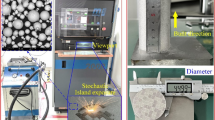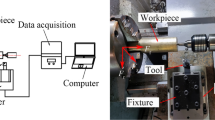Abstract
The effect of the shape of powder particles, their size, and the degree of irregularity on the characteristics of the actual contact of a magnetic-abrasive tool (MAT) with the surface of articles being machined is studied. It was established that the relative area of the actual powder contact with the surface is 4–10%. A model representation of an MAT is suggested in the form of tetrahedral quasistable formations and the features of powder tool formation within annular gaps in the form of quasistable volumes are described.
Similar content being viewed by others
References
V. E. Oliker,Powders for Magnetic-Abrasive Machining and Wear-Resistant Coatings [in Russian], Metallurgiya, Moscow (1990).
V. V. Panichkina and I. V. Uvarova,Method for Monitoring the Fineness and Specific Surface of Metal Powders [in Russian], Nauk. Dumka, Kiev (1973).
M. D. Krymskii, “Distribution and compaction magnetic-abrasive powder within the operating gap of a machine,” in:Magnetic-Abrasive Materials and Methods for Testing Them [in Russian], Inst. Probl. Materials Sci., Acad. Sci. Ukrainian SSR, Kiev (1980).
V. S. Maiboroda and V. Ya. Shlyuka, “Features of ferro-abrasive powder movement during magnetic-abrasive machining,”Poroshk. Metall., No. 8, 3–8 (1987).
V. S. Maiboroda, O. V. Stepanov, V. Ya., Shlyuko, et al., “Study of magnetic-abrasive machining conditions with annular arangement of magnetic gaps,”Tekh. Avtomizats. Mashinostr., No. 42, 75–79 (1988).
V. S. Maiboroda, O. V. Stepanov, V. Ya. Shlyuko, et al., “Features of ferro-abrasive powder formation in a magnetic-abrasive tool under conditions of an annular arrangement magnetic gaps,”Poroshk. Metall., No. 5, 72–76 (1989).
Yu. M. Baron,Magnetic-Abrasive and Magnetic Machining of Articles and Cutting Tools [in Russian], Mashinostroenie, Leningrad (1986).
F. Yu. Sakulevich,Bases of Magnetic-Abrasive Machining [in Russian], Nauka i Tekhnika, Minsk (1981).
S. A. Saltykov,Stereometric Metallography [in Russian], Metallurgiya, Moscow (1976).
O. V. Stepanov, “Study the formation of powder magnetic-abrasive tools for machining articles of complex shape,”Diss. Cand. Tech. Sci. Kiev, (1997).
V. S. Maiboroda, V. Ya. Shlyuko, and T. Ya. Grigasova, “Features of powder movement during magnetic-abrasive polishing of small article of complex configuration,”Poroshk. Metall., No. 7, 90–95 (1985).
L. M. Vyazovskaya, B. I. Kramarovskii, V. S. Maiboroda, et al., “Use of a magnetic-abrasive method for machining blades,”Aviatsion. Prom., No. 9, 20–22 (1990).
V. S. Maiboroda, O. V. Stepanov, and V. Ya. Shlyuk, “Effect of a magnetic field on the magnetic characteristics of a magnetic-abrasive powder tool,” in:Proc. Scientific and Procedural Work of the Kiev Polytechnic Institure, 50th Anniversary of the Engineering-Physics Faculty, Part 2 [in Russian], Znanie, Kiev (1994).
Additional information
Ukrainian National Technical University “Kiev Polytechnic Institute”. Translated from Poroshkovaya Metallurgiya. Nos. 7–8(408), pp. 117–121, July–August, 1999.
Rights and permissions
About this article
Cite this article
Maiboroda, V.S. Interaction of a powder magnetic-abrasive tool with the surface of an articles in annular gaps. Powder Metall Met Ceram 38, 424–427 (1999). https://doi.org/10.1007/BF02676181
Received:
Issue Date:
DOI: https://doi.org/10.1007/BF02676181




